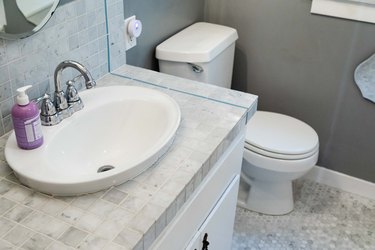Do you find yourself on the lookout for critical info involving Toilet Flanges?

Intro:
Recognizing the Importance of a Toilet Flange:
In the world of plumbing, the often-overlooked bathroom flange plays a critical duty in guaranteeing the smooth operation of your washroom components. As an essential port between your toilet and the underlying drain, the commode flange acts as the unhonored hero of your plumbing system. Without this sturdy part, your toilet would be prone to instability and leakages, potentially causing pricey repairs and aggravation. As a result, comprehending the relevance of a properly mounted and maintained toilet flange is vital for any type of home owner starting plumbing tasks or dealing with repair needs.
Why Proper Installation and Maintenance Matter:
Appropriate installment and meticulous maintenance of the bathroom flange are crucial for safeguarding the integrity of your plumbing infrastructure. A meticulously installed flange not only anchors your toilet securely in place but likewise develops a bulletproof seal, warding off the perils of leakages and smells. By accepting a positive approach to flange maintenance, you can reduce the risk of turbulent plumbing problems and preserve the serenity of your home setting. Throughout this insightful overview, we'll unwind the complexities of bathroom flange installation and repair, equipping you with the understanding and knowledge to navigate these important jobs adeptly.
Best Practices When Installing a Toilet Flange:
Making sure a smooth toilet flange setup requires adherence to a collection of ideal techniques that ensure longevity and performance. Begin by meticulously assessing your tools and products, ensuring you have the needed tools for the work in advance. Choosing the proper flange material, whether PVC, ABS, or cast iron, is critical, as it determines the long life and efficiency of your plumbing fixture. In addition, reviewing existing plumbing conditions, such as looking for damage or corrosion, is crucial for preemptively attending to potential difficulties and guaranteeing a smooth installment process. By taking on these preparatory procedures, you established a solid structure for an effective toilet flange installment, reducing the chance of future issues and assisting in long-lasting upkeep.
As soon as sufficiently prepared, wage the careful elimination of the old flange, adhering to a methodical method to stay clear of triggering damages to bordering parts. Use strategies tailored to deal with persistent or rusted flanges, guaranteeing their swift and risk-free removal without compromising the stability of the surrounding plumbing facilities. With the old flange removed, meticulously set up the new substitute flange, picking one that fits well and firmly right into area. Appropriately protecting the flange to the floor using screws or adhesive is important, as it guarantees stability and protects against future leakages. By sticking to these ideal methods during the installment process, you lay the groundwork for a durable and reputable bathroom flange setup that withstands the examination of time.
Mounting a New Toilet Flange:
When installing a new commode flange, the initial step is to pick the appropriate substitute for your plumbing configuration. Take into consideration elements such as the material of the flange, with choices consisting of PVC, ABS, or cast iron. PVC flanges are understood for their price and resistance to deterioration, making them a popular choice for DIY enthusiasts. Abdominal muscle flanges offer comparable benefits to PVC however boast added durability, making them appropriate for high-traffic locations or commercial settings. Cast iron flanges, renowned for their toughness and durability, are suitable for installations where toughness is paramount. Additionally, ensure that the replacement flange is correctly sized and fits comfortably right into place to create a leak-proof seal and prevent leakages.
Safeguarding the Flange to the Floor:
Once you've chosen the ideal substitute flange, it's important to protect it properly to the flooring to make sure stability and stop future problems. Begin by placing and lining up the flange properly over the waste pipe, making sure that it sits flush with the flooring surface. Depending on the sort of flange and your particular installation choices, you can protect the flange to the flooring making use of screws or adhesive. If making use of screws, make sure to use corrosion-resistant alternatives to avoid rusting over time. Conversely, adhesive can give a safe bond in between the flange and the floor, ensuring a strong and trustworthy installment. By complying with these steps and taking the necessary safety measures, you can mount a brand-new commode flange with confidence, guaranteeing a lasting and leak-free plumbing fixture.
Best Practices When Repairing a Broken Flange:
Fixing a damaged bathroom flange demands thorough focus to information and adherence to best practices to ensure a lasting remedy. Begin by completely evaluating the level of the damages and determining the underlying reason, whether it be rust, cracks, or imbalance. This assessment will lead your repair work strategy, permitting you to pick one of the most appropriate methods and products for recovering the flange to its ideal problem. Additionally, take into consideration the surrounding plumbing infrastructure and flooring stability to attend to any prospective contributing elements and protect against future issues from arising. By performing a comprehensive analysis and analysis, you prepared for an effective and long-lasting repair work procedure that resolves the root cause of the trouble.
With a clear understanding of the flange's problem and the aspects influencing its damage, wage the fixing procedure utilizing precision and treatment. Relying on the severity of the damages, you may select repair service techniques such as epoxy putty, repair flange packages, or partial flange replacements. Ensure that the picked fixing approach effectively addresses the specific issues at hand while maintaining the structural integrity and capability of the flange. In addition, take proactive measures to strengthen the repaired flange and prevent future damage, such as using sealer or waterproofing products to guard versus leaks and corrosion. By adhering to these ideal methods throughout the repair work procedure, you can recover your damaged flange to optimal condition, making certain the long-lasting dependability and efficiency of your plumbing system.
Sorts Of Toilet Flanges:
Comprehending the various types of commode flanges is necessary for selecting one of the most suitable alternative for your plumbing needs. PVC, ABS, and cast iron are amongst the typical materials made use of in bathroom flange building and construction, each offering distinctive advantages and factors to consider. PVC flanges, known for their price and rust resistance, are favoured for their ease of installation and longevity. Abdominal flanges, comparable to PVC in regards to cost and convenience of installation, are prized for their toughness and resistance to impacts. On the other hand, cast iron flanges, renowned for their extraordinary strength and durability, are often favored for high-traffic areas or business settings where sturdiness is extremely important. By acquainting on your own with the characteristics of each material, you can make an informed choice when picking a bathroom flange that aligns with your specific requirements and choices.
In addition to product factors to consider, bathroom flanges also are available in different styles and designs to fit different plumbing configurations and installation preferences. Offset flanges, for example, are created to accommodate bathrooms mounted on floors that are uneven or where the waste pipe lies off-centre. In a similar way, repair service flanges, additionally known as repair rings or spacer rings, are used to attend to concerns such as fractured or broken flanges without the need for considerable plumbing adjustments. In addition, flexible flanges provide versatility ready, permitting specific alignment and fit during installment. By discovering the varied variety of commode flange types and designs available, you can select the option that ideal matches your plumbing arrangement and setup demands, making sure a seamless and trustworthy option for your restroom fixtures.
Specialized Options:
In addition to standard toilet flanges, there are specialty alternatives available to deal with certain plumbing challenges and installation preferences. One such choice is the countered flange, which is designed to accommodate bathrooms set up on floorings that are uneven or where the drain lies off-centre. Countered flanges include an one-of-a-kind layout that allows the toilet to be placed at a slight angle, compensating for uneven flooring or misaligned plumbing links. This cutting-edge remedy ensures a secure and secure installment, getting rid of the need for expensive and lengthy flooring leveling or pipeline moving. By including an offset flange right into your plumbing setup, you can conquer common installation obstacles and achieve a professional-quality outcome easily.
One more specialty option worth considering is the repair flange, additionally referred to as a repair service ring or spacer ring. Repair flanges are particularly designed to attend to problems such as cracked or damaged toilet flanges without the demand for considerable plumbing modifications. These functional components can be set up straight over the existing flange, providing a strong and dependable base for protecting the commode in position. Repair flanges come in different dimensions and arrangements to accommodate different flange diameters and setup demands, making them a practical and cost-efficient remedy for resolving flange-related problems. Whether you're handling a minor flange repair or a more intricate plumbing concern, integrating specialty alternatives like balanced out and repair work flanges can improve the setup procedure and ensure lasting efficiency for your restroom components.
Final thought:
In conclusion, grasping the art of toilet flange installation and repair work is vital for maintaining a practical and leak-free plumbing system in your home. By comprehending the importance of a correctly installed flange and adhering to ideal practices throughout the procedure, you can make certain the longevity and dependability of your bathroom fixtures. Whether you're choosing the appropriate kind of flange, performing repair work, or discovering specialized alternatives, focus to information and meticulous implementation are vital. Routine maintenance and positive repairing can aid prevent pricey plumbing concerns and protect the serenity of your home environment. Equipped with the expertise and abilities obtained from this detailed guide, you can take on toilet flange installment and repair service with confidence, empowering you to guard your plumbing system for several years to find.
How to Replace a Toilet Flange
The toilet flange is the part that keeps your toilet attached to the drain. A broken toilet flange will result in your toilet moving around and can even cause it to leak.
A broken toilet can be such a headache and the leaking water can even cause further damage. Many people don’t know about the different elements of replacing a toilet or fitting a new toilet, and it’s important to know these skills when you’re a homeowner.
This article will walk you through how to quickly and correctly do a toilet flange repair.
How to Replace a Toilet Flange
A toilet flange is a critical element of a toilet, but it serves two separate functions. For instance, a toilet flange secures your toilet unit onto the ground and connects the toilet bowl to the wastewater line.
Often, a toilet flange is already in place when installing a toilet, so many homes have these features but never think of them until they are broken. Therefore, you need to know when to replace a toilet flange.
Remove the Toilet
The first stage is removing the toilet and disconnecting the structure from the water supply. You can close the knob at the back of the toilet and empty the toilet tank several times.
After this, you should remove the water hose from the toilet. It’s essential to cover your bathroom floor with newspaper or a tarp to ensure there’s no external damage to your space.
This can be a complicated process, so getting professional help may be necessary if you don’t feel confident about replacing a toilet flange. When you work with an experienced professional, you can ensure the job is done correctly.
Unscrew Two Nuts and Bolts
The two nuts and bolts are the parts that hold the toilet to the flange and floor, so you need to tackle this part next. You can use an adjustable wrench if the nuts are secure and too tight.
After this, you can set the nuts aside in a container and reattach the toilet when the flange is completely repaired.
Remove the Old Wax
Next, after you’ve removed the toilet and nuts and bolts features, you should remove the old wax that sealed the toilet to the flange. You can quickly eliminate the old wax with a putty knife or other similar tool.
Work your way down the build-up of old wax until you reach the top of the toilet flange.
Remove the Flange
Once you reach the flange structure, you can search for the screws outside the part. All you need to remove the screws is a multi-head screwdriver, allowing you to remove different screws.
You can remove the flange and clean it with disinfectant or a wipe to sanitize the surface area. It’s also a good idea to stuff an old towel or cloth into the space to prevent odors and gasses from oozing from the area.
This is where you need to measure the diameter of the outflow pipe’s mouth to find the identical part to replace the toilet flange. You must have exact measurements when searching for a new flange.
Otherwise, you will buy a new toilet flange that can be used in your bathroom.
You can also take the old toilet flange in a secure bag to your local hardware shop if you want to make a direct comparison with a new product. You must also buy sealing wax for the new toilet flange.
If you need help buying a new toilet flange, a professional plumber can help or an employee at your local store.
Apply New Flange and Fit Toilet
At this point, you can fit the new toilet flange following the instructions given with the product, or you can hire a professional to do the job for you. You should also apply the new seal wax around the mouth.
This will allow the toilet flange to stay in place and not become broken again shortly.
Finally, you can fit the toilet structure back in place by securing the nuts and bolts again. You should reattach the water supply and test the flush to check that the water is running correctly.
To test the water supply, you can flush the toilet several times and wait for the water to fill up and empty repeatedly.
The last step is to tidy the bathroom space and clear away the dirty towels or newspapers. It’s a good idea to clean the floors with a strong disinfectant to eliminate the odors left behind.
With experience, you can fix the toilet flange in no time. But, if you’ve never handled these toilet parts, you should hire a professional plumber to take care of them.
Thankfully, our team is here for you. We have the best plumbers in Detroit to help you fix any toilet issues you encounter at home.
https://waterworkplumbing.com/how-to-replace-a-toilet-flange/

As a keen person who reads on Fix a Broken Toilet Flange, I think sharing that piece was beneficial. Kindly take the opportunity to share this article if you appreciated it. We thank you for reading our article about Toilet Flanges.
Contact
 Yasmine Bleeth Then & Now!
Yasmine Bleeth Then & Now! Suri Cruise Then & Now!
Suri Cruise Then & Now! Lynda Carter Then & Now!
Lynda Carter Then & Now! Christy Canyon Then & Now!
Christy Canyon Then & Now! Dolly Parton Then & Now!
Dolly Parton Then & Now!